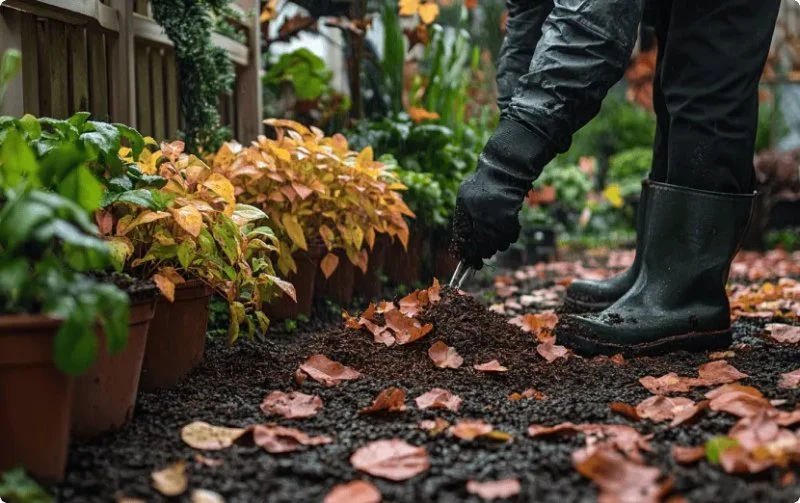
- 1- The Importance of Frost Protection
- 2- Common Types of Frost Damage to Plants
- 3- Practical Tips for Protecting Your Plants from Frost
- 4- Recommended Products for Frost Protection
- 5- Real-Life Examples and Case Studies
- 6- Long-Term Strategies for Winter Plant Care
1. The Importance of Frost Protection
Frost can be a gardener’s worst nightmare, especially during early spring or late autumn when temperatures unexpectedly drop. Protecting plants from frost and freeze damage is essential to ensuring their survival through the cold months. Frost damage can kill delicate plants, stunt their growth, or even ruin a year’s worth of gardening effort. Understanding how to prevent frost damage can help you avoid this unfortunate outcome, allowing your garden to thrive year-round.
2. Common Types of Frost Damage to Plants
Frost damage occurs in different forms, each affecting your plants in unique ways. The most common types of frost damage include:
- Cell Damage: When the water inside a plant's cells freezes, it can cause cell walls to rupture, damaging the plant's tissues.
- Wilting and Browning: As the frost thaws, affected plants may show signs of wilting, yellowing, or browning of their leaves.
- Frozen Roots: Frost can extend into the soil, freezing the roots of plants, which may lead to root rot once temperatures rise again.
Identifying these types of frost damage early can help you take the necessary steps to protect your plants from further harm.
3. Practical Tips for Protecting Your Plants from Frost
There are several ways to protect your plants from frost, depending on the severity of the freeze and the type of plants in your garden. Here are a few practical and easy-to-implement tips:
- Cover Plants with Cloth or Burlap: Use a cloth cover, such as frost blankets, burlap, or old sheets, to shield your plants from frost. Ensure the covers touch the ground to trap heat.
- Water Your Plants Before a Freeze: Well-hydrated plants are better equipped to handle cold temperatures. Water your plants thoroughly in the evening before a freeze to help insulate their roots.
- Use Mulch: Applying a thick layer of mulch around the base of your plants helps insulate the soil and roots, keeping them warmer during a frost.
- Move Potted Plants Indoors: If you have potted plants, bring them indoors or into a greenhouse before the temperature drops.
4. Recommended Products for Frost Protection
To ensure maximum protection for your plants, consider investing in some quality products designed specifically for frost protection. These include:
- Frost Blankets and Covers: These are designed to protect plants from frost while allowing light and moisture to reach them. Available in different materials, frost blankets are an easy and affordable solution for preventing freeze damage.
- Heater Fans and Frost Protection Heaters: These can be placed in greenhouses or around sensitive plants to maintain a warm environment during a frost event.
- Row Covers: Ideal for covering entire rows of plants, these fabric covers help retain heat and prevent frost from reaching your plants.
At Beautiful Landscapes, you can find high-quality frost protection products tailored to your gardening needs, ensuring the health and safety of your plants throughout the winter months.
5. Real-Life Examples and Case Studies
Several gardeners have experienced success in protecting their plants from frost using these strategies. For example, one gardener in Michigan shared how covering their tomato plants with frost blankets during a late spring freeze helped save their crop. Without this simple protection, they would have lost their tomatoes before harvest.
Similarly, a couple in Colorado used mulch around their rose bushes and moved their potted plants indoors during a sudden drop in temperature. The roses survived the frost without any visible damage, while their potted plants thrived indoors during the winter.
6. Long-Term Strategies for Winter Plant Care
To protect your garden from frost and freeze damage in the long run, it’s essential to develop a year-round care routine for your plants. Some strategies include:
- Plant Frost-Resistant Species: Consider planting varieties that are naturally resistant to cold weather, such as certain types of evergreen shrubs and hardy perennials.
- Build Windbreaks: Constructing windbreaks around your garden can reduce the wind chill factor, making it easier for your plants to survive freezing conditions.
- Use Cold Frames or Greenhouses: Cold frames or greenhouses provide a controlled environment for your plants, reducing their exposure to the harshest elements of winter.
By following these strategies and preparing for cold weather, you can ensure that your plants remain healthy and protected throughout the winter season.









 Fetter's Farm &garden5.0 (2 reviews)
Fetter's Farm &garden5.0 (2 reviews) Stanley Landscapes5.0 (14 reviews)
Stanley Landscapes5.0 (14 reviews) One Fine Cut Landscaping5.0 (1 reviews)
One Fine Cut Landscaping5.0 (1 reviews) Green Key Landscape Design4.0 (7 reviews)
Green Key Landscape Design4.0 (7 reviews) J&S Mowing and More5.0 (2 reviews)
J&S Mowing and More5.0 (2 reviews) Superior Landscaping3.0 (20 reviews)
Superior Landscaping3.0 (20 reviews) Best Ground Covers for Slopes & Erosion Control: Affordable and Effective Solutions
Best Ground Covers for Slopes & Erosion Control: Affordable and Effective Solutions How to Build a Pathway That Blends With Nature: A Step-by-Step Guide
How to Build a Pathway That Blends With Nature: A Step-by-Step Guide How to Use Shade & Sun Zones to Maximize Space: Smart Outdoor Design Tips
How to Use Shade & Sun Zones to Maximize Space: Smart Outdoor Design Tips How to Landscape With Ornamental Edibles for Dual Use
How to Landscape With Ornamental Edibles for Dual Use How to Care for a Newly Planted Landscape: Expert Tips for Healthy Growth
How to Care for a Newly Planted Landscape: Expert Tips for Healthy Growth How to Build a Stone Pathway With a Natural Flow
How to Build a Stone Pathway With a Natural Flow